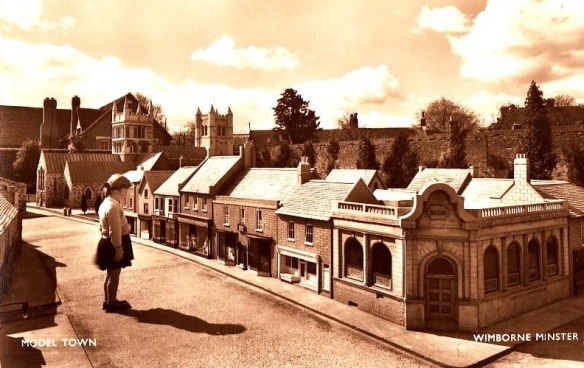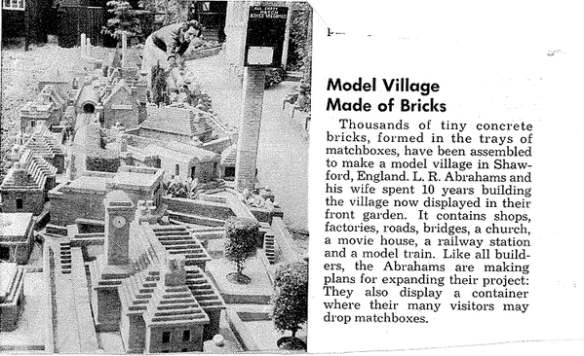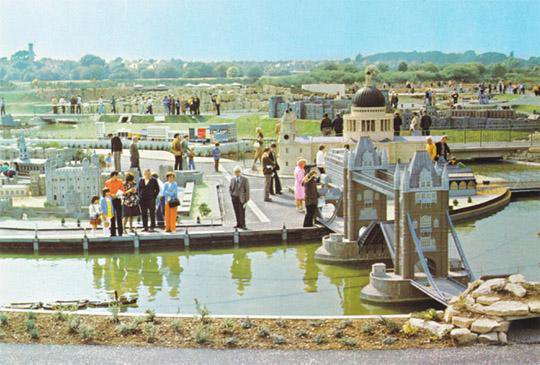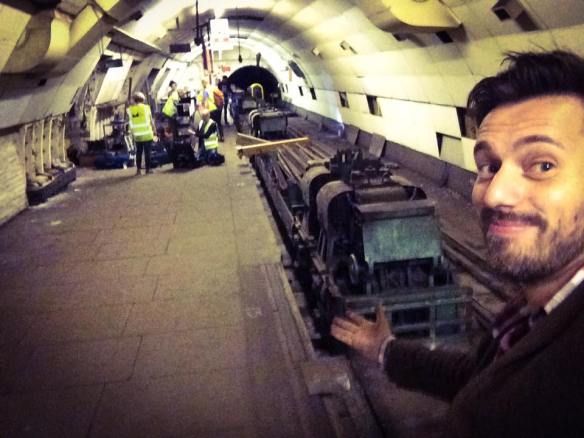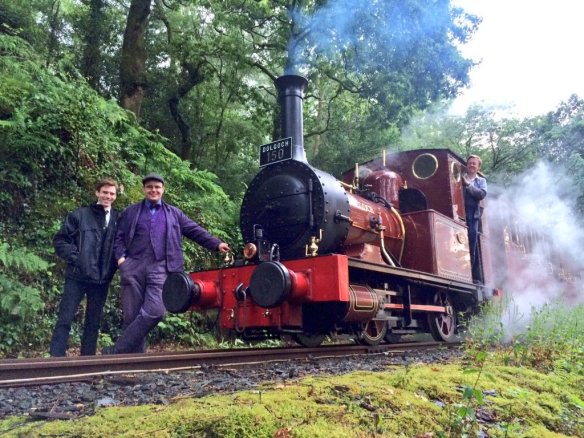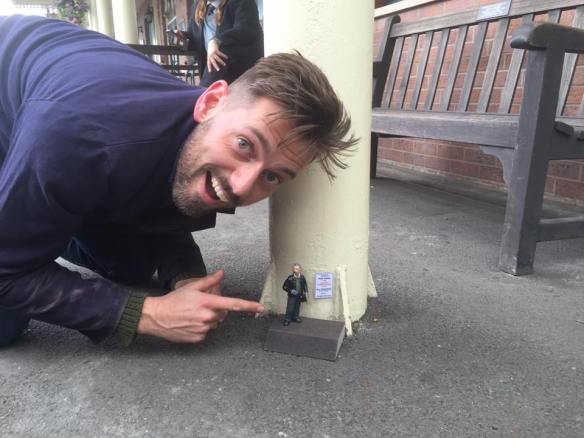Ever since I was a small Timmy, I’ve loved trains. When you grow up near Britain’s biggest model train set, at Bekonscot Model Village in Beaconsfield, Buckinghamshire, it’s going to affect you in some way. As the son of a railway-loving chartered surveyor, and the grandson of two grandfathers who built model trains, miniature railways, enjoyed gardening, and exploring weird and wonderful places, let’s be honest, it’s going to give you either a God complex or a size complex.
Or both.

Me on my first visit to Bekonscot. I’m impatiently waiting for a train.
I pestered Bekonscot until they let me work there at the age of 12, having the best (or most Enid-Blyton-esque) job anybody could ever want. I controlled the model trains, I occasionally repainted or fixed the tiny figures and I built some model buildings. I made some life-long friends through my work there, through our shared love of skilled craftsmanship or just simply playing trains. I had an idyllic childhood: I was very lucky. Not only did I grow up in the leafy suburban Chiltern Hills around Betjeman’s Metro-land, but I also had this miniature kingdom on my doorstep.
I knew I was lucky, and I wanted to share the charm, the wit and the supreme quirkiness of this Lilliput with the rest of the world, so my brother and I built the early Bekonscot websites. Some versions of the site included very suburban English version of SimCity called the Virtual Village; these were tiny bits of pixel art I designed in Microsoft Paint, each building either something from my own life or a representation of something at Bekonscot. Bekonscot found itself at the cutting edge of internet gaming (no, really!) so after a few years of appearing on schools’ ICT syllabuses we had more than 500,000 little virtual villages saved. And only a few of them were built by me.
Talking of the cutting edge of the internet, you can now follow my miniature exploits on Twitter at http://www.twitter.com/MrTimDunn

We launch the Bekonscot website in 2002
Over the years, we decided that a ride-on-railway would be an excellent additional visitor attraction at the village. The chief mechanical engineer, Mervyn Hill, and I, contrived a convoluted little circuit and I helped build it with the rest of the staff. I bought a few of my own locomotives (seven and a quarter inch gauge, for those of you who are interested in such things) and I’ve run them there occasionally ever since. It turns out that the visitors enjoyed it too: over 1 million passengers have had a ride on the Bekonscot Light Railway since we opened it – it’s a profitable little enterprise and all of that cash, as all of Bekonscot’s profits do, have gone to worthy charities. Most of those charities don’t know they’re going to get a donation from Bekonscot until the cheque appears in the post.
To me, that’s what makes Bekonscot so special. Each and every one of those 15 million people has visited because they wished to experience a bit of joy. By visiting, their money then gets transferred to people who can’t visit, or who might need a bit of joy too. It’s quite, quite brilliant in its simplicity: it’s the perfect tourist attraction. Your visit will make somebody else’s day.

They actually let me play trains with my new toy. I’m looking really quite a bit younger here. My Inter-City 125 is in storage these days but one day we’ll get it out and play again.
In the years that followed, I became known amongst the model village operators of Britain as something of a historian of miniature history – and thanks to them, my poor parents are now the custodians of various model buildings including a model of Dudley High Street we rescued from a long-abandoned Himley Hall Model Village, a Statue of the Motherland (Russia) and a 9 metre tall Eiffel Tower from Thorpe Park. All of these, the Eiffel Tower included, are stored at various family-owned locations. My uncle threatens to grow his runner beans up it, and at Christmases out at one family home, the nude Colossus of Rhodes model occasionally gets a willy-warmer and a tinsel halo. We know how to live.

Himley Hall Model Village – abandoned in 1993 and parts rescued by us before the site was flattened

Taking the Statue of the Motherland (from Thorpe Park’s old Model World) on a roadtrip
I say “became known” amongst model village people – well – I made myself known. In 2004, Bekonscot celebrated its 75th birthday. I decided that this was a suitable point to break my nascent post-university career in PR (I didn’t enjoy trying to convince journalists that server-side technology was interesting) and spent a very happy summer at Bekonscot getting us on telly, in papers and on radio around the world. Then I went off to do marketing things elsewhere in agencies and as a client (now I run a team of email and content marketers much cleverer than myself) but have because of the research I started 11 years ago, I’m still tracking down and hunting out the miniature towns and villages of the world. But why?

Roland Callingham, creator of Bekonscot Model Village, in 1929
Bekonscot is an incredible place. Opened in 1929 by Roland Callingham, this wealthy philanthropist and his staff used this Lilliputian creation to show his aristocratic friends – and the Royal Family who visited several times privately – not just what Britain was like, but what it could be.
Callingham was a progressive. He showed how good housing and good town and country planning could benefit the landscape, not detract from it. Now, 86 years later as we find Britain under the greatest pressure to deliver homes and housing for all, his ideals of marrying the built environment with the natural one are a debate worth having all over again. Suddenly, Bekonscot is relevant again, if we look past the quaint thatch and the steam locomotives.
What is our utopia? What kind of place do we really want to live in? This question is raised the the existence of a “model town” and in more recent years we’ve seen the creation of new full-size model villages, designed as real live-in model villages by developers. My most recent involvement has been to see the construction of a new model town at Bekonscot: designed by me on paper about eight years ago but expertly realised and constructed by brilliant modelmakers, engineers and craftsman. My urban plan for a model town of all types of architecture; a mish-mash palimpsest where kids and adults can get hands-on with a townscape of the past (and hopefully think a bit about why towns look like they do) is now being constructed in 3D.

Bekonscot’s New Town development as designed by me circa. 2007…
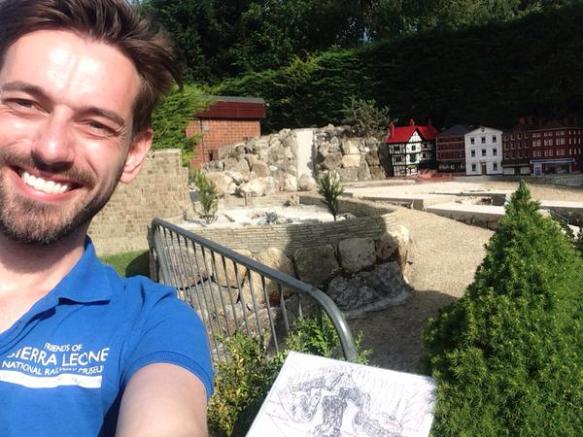
A very happy me seeing the modelmakers’ interpretation of the plans #idiotselfie
Bekonscot today is the result of dozens of talented craftsmen, adding and subtracting to the landscape. There are actually seven distinct villages there – plus more than 10 scale miles of model railway. It’s a place where we, as adults, can indulge our politics, our theories, our ideals – democratically and in context of 86 years of development. Bekonscot is an 86 year old team hobby and indeed an employer for many that has grown to become a reflection of British society, albeit a depiction of 1930s life.
The reason I find model villages fascinating is because there’s more to some of these suburban Lilliputs like dear old Bekonscot than meets the eye: exactly whose reality is being miniaturised? Who decides what is to appear, and what is not? Does the a model capture a moment to be preserve a moment in aspic for all time, or should it be constantly adapted and updated to reflect changes to the full-sized original world outside?
I’ve asked many private and commercial model village owners these questions and their answers have been varied and fascinating. Edward Robinson single-handedly created the Lakeland Miniature Village in Cumbria: “I wanted to show the kids what went before,” he told me, gesturing across the beautifully crafted slate-hewn Lakeland vernacular buildings scattered over rolling hills in his front garden. “Real rural life. Before the barns all became barn conversions.” So this isn’t Lakeland today; it’s a museum of Lakeland history. And not any old history – this is Edward’s history.
Little Italy, founded by the late Mark Bourne, occupies a Welsh mountainside garden above Corris. Bourne loved Italy so much that he made towering, folk-art models to show local people the beauty of classical Italian architecture. So here we have the Duomo from Florence, the Bridge of Sighs from Venice and a Tower of Pisa that is now leaning a little more dangerously than its full-sized prototype. It’s a wonderful place, but like Lakeland it’s a very personal historical record, where architectural and planning policy is governed by one person’s taste and memory alone.

An idiot abroad: me in Little Italy, 2007
Miniature Britain has been ruled by characters who will stop at neither historical accuracy nor architectural espionage to further their tiny empires. In Skegness, their model village has a series of vernacular buildings identical to those found in two model villages on the south coast; Skegness depicts Sussex and Wealden vernacular because its builder is said to have ‘acquired’ the moulds to cast the concrete models by nefarious means after he worked briefly at those southern villages. They do indeed look precisely the same, giving visitors a slightly skewed idea of what East Yorkshire’s rural settlements must look like.

Me at Godshill Model Village this year
But perhaps we’re looking too hard. Model villages are about joy – they’re about the suspension of reality. People go to them to escape for a bit, to reminisce, or forget. They’re full of silly things, they’re full of joyful things, they’re full of things that we wish for. They bring out the child in us – because suddenly the world isn’t such a scary place full of responsibilities after all.
In this journey of discovering our parallel miniature world, I’m fast learning that I can’t entirely suspend my sensibilities and desire to dig out the darker side. (Let’s not even mention the hidden Soho scene at Legoland). Each one seems to have a less visitor-friendly backstory to tell. But do visitors care and should we worry that a one-sided fake history that never was is being peddled? Perhaps I’m taking this all too seriously. To make up your own mind, you need to visit a model village for yourself, and I really hope you do.
In the meantime, Happy Birthday, Bekonscot. May you make millions more people as happy as you’ve made me.
(If you’ve enjoyed this, please do follow my miniature travels on http://www.twitter.com/MrTimDunn – I’d love to have you for company.)



